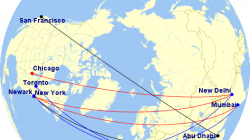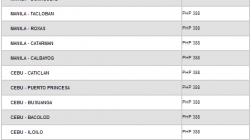The Federal Aviation Administration has upgraded carriers registered in the Republic of the Philippines from Category 2 to Category 1 status, a rating that airlines such as Philippine Airlines (PAL) and low-cost carrier Cebu Pacific Air have held since January 2008. Airlines are placed under Category 2 restrictions when they fall out of accordance with minimum civil aviation standards set by the International Civil Aviation Organization (ICAO). Until they pass regulatory safety audits and are restored to Category 1 status, they cannot add flights and services to U.S. markets, nor codeshare with U.S. airlines.
There are currently 10 countries remaining in Category 2: Bangladesh, Barbados, Curacao, Ghana, India, Indonesia, Nicaragua, Serbia, Saint Maarten and Uruguay. Of these ten countries, only two – India and Philippines – send their foreign carriers to U.S. soil. India is the most recent country to be placed under Category 2 back in January 2014.
Related post: India downgraded to Category 2 safety rating by US FAA
India, has been majorly affected by the change as its flag carrier, Air India, has impending plans to join Star Alliance but cannot enjoy the full benefits of alliance membership until the restrictions are lifted. Also greatly impacted has been Jet Airways Ltd, which formed a partnership with Abu Dhabi-based Etihad Airways in April 2013 to capture a greater share of sixth-freedom traffic between the U.S. and India over Abu Dhabi. Jet was slated to open new US routes from AUH which have now been placed on hold.
Category 1 will at last provide a major game-change opportunity for Filipino airlines
Filipino carriers, mainly PAL, have long suffered from the lack of expansion opportunities caused by ICAO restrictions. Until recently, the Philippines was also placed on an EU blacklist, in addition to the US Category 2 ratings. Both have since been removed.
PAL’s international network is heavily concentrated around the Asia-Pacific region, with a mere 13.7% of its long-haul operations serving the North America region and 8.1% dedicated to the Middle East. It recently launched nonstop services from Manila to London Heathrow with a 5-weekly 777-300ER service. The carrier has also stated that plans in the pipeline to expand into Amsterdam, Frankfurt, Paris and Rome in the near future.
In the Americas, PAL currently serves Honolulu, Los Angeles, San Francisco, Vancouver and Toronto.
Low-cost carrier Cebu Pacific Air has recently acquired several Airbus A330s to be used on medium-to-long haul routes to the Middle East, and has also stated intentions of serving the US with their longer-range aircraft, most likely to Guam and Hawaii, if not possibly the US West Coast. However, the priority of serving the US is much lower for Cebu than PAL.
PAL will face fleet challenges with expansion
PAL currently has six 77Ws in service, but has no future orders in place. There are 12 orders for Airbus A330 variants, including 2 A330-E types and 10 A330X. Despite stating ambitious plans for expanding into the US and European Union, PAL will need extra slack in its widebody fleet in order to make this possible from a utilization perspective.
Pal currently deploys its 77Ws on three routes: its 5-weekly operation from Manila to London Heathrow, a 3-weekly service to Tokyo Haneda, and a 3-weekly service to Toronto, which operates via Vancouver in each direction.
While there are certainly spare 777s for PAL to use on longer-range routes, it faces the challenging choice of either replacing current fleet variants used for certain markets with the more cost-efficient 77Ws, or keeping those aircraft types in place and instead opening up new long-haul routes. PAL currently has 8 Airbus A340s and 5 Boeing 747-400s in operation, and it sends its Airbus A340s to Honolulu and Los Angeles, and its Boeing 747-400s to Los Angeles and San Francisco.
Under category 2, PAL could not adjust its fleet types nor capacity to any of its US markets until the restrictions were lifted. Now that it has the freedom to do so, it can deploy the 77Ws on the existing markets, which were the originally-intended destinations for 777 use back when PAL placed the fleet order. Of course, PAL cannot successfully accomplish three stated intentions of not only replacing existing A340 and 747 long-haul markets in the US, but also opening up new stations in Europe and the United States.
The likeliest scenario is that PAL will prioritize the U.S. over Europe, given that it holds a monopoly on nonstop routes between the two countries. The only other carriers serving the US-Philippines market are 6th freedom airlines, and even U.S. based carriers such as Delta and United, both of which fly to Manila, operate from non-mainland gateway airports such as Tokyo and Nagoya (Delta) and Guam (United).
Europe, on the other hand, poses far more risks for PAL than the U.S. Though the Filipino diaspora in Europe is large, the market is saturated with plenty of 6th-freedom competition from Asian, European and Middle Eastern carriers alike. The latter, in particular, is very formidable with Emirates offering 3 daily flights into Manila on high-density 777s. With its foot through the door in Heathrow, PAL will likely evaluate how the market performs over the long run before considering further expansion into other EU airports. Theoretically, PAL could theoretically deploy some of its A340s to market such as Frankfurt and Paris, although a 77W is far more desirable.
Moreover, PAL has stated that the U.S. is its most profitable region, which speaks positively about its ability to attract decent revenue mixes despite utilizing high-CASM equipment on these routes. The carrier has expressed interest in moving beyond the US west coast into New York and possibly Chicago as new expansion opportunities.
PAL can now look to possibly joining an alliance as it tries to make up for lost time
PAL has lost out on opportunities to stronger Asian competitors such as Cathay Pacific, Korean Air and ANA as its fleet, product and financial situation waned. But, with new opportunities on the horizon, and the chains lifted from growing its network, it may want to consider joining a global alliance to help build its strength in new regions.
The Philippines market in and of itself only sees 16.5% representation from the three major global alliances. OneWorld is the largest at 6.3%, followed by Star Alliance at 5.3% and SkyTeam at 5.0%.
Truthfully speaking, PAL is actually a fairly small and weak player in the overal market, comprising of only 15.1% overall market share, by seats. Cebu, by far, is the largest with 36.9% market share. However, as an entirely no-frills low-cost carrier, Cebu will not be partaking in any global alliance membership in the near-term future.
That being said, the benefits that PAL would add to any three major alliances are fairly muted, but alliances are always open to growing their lists of members, even if the carriers’ contributions are minor. For any of the three major groups, adding PAL would only grow representation in the Philippines to a mere 20-24%, at best, but there would be value-added in the form of enhanced connections, codeshare agreements, frequent flier benefits and joint ventures.
PAL may also simply just adopt an agnostic approach to alliances and instead formulate deeper codeshare agreements with local carriers, starting first in the U.S. Routes to new markets such as Chicago and New York will need to rely on codeshare agreements to help develop the network. This could serve as a good wake-up call for American, who remains the only U.S. carrier without a Filipino presence, to capitalize on codeshare and interline opportunities with PAL at LAX, or Chicago and New York JFK (if those routes materialize). Miami to Manila is also one of the largest under-served international markets from the U.S. without a single non-stop competitor. Granting easier access to travelers between these two stations could be facilitated via an American codeshare over Chicago and/or New York.


